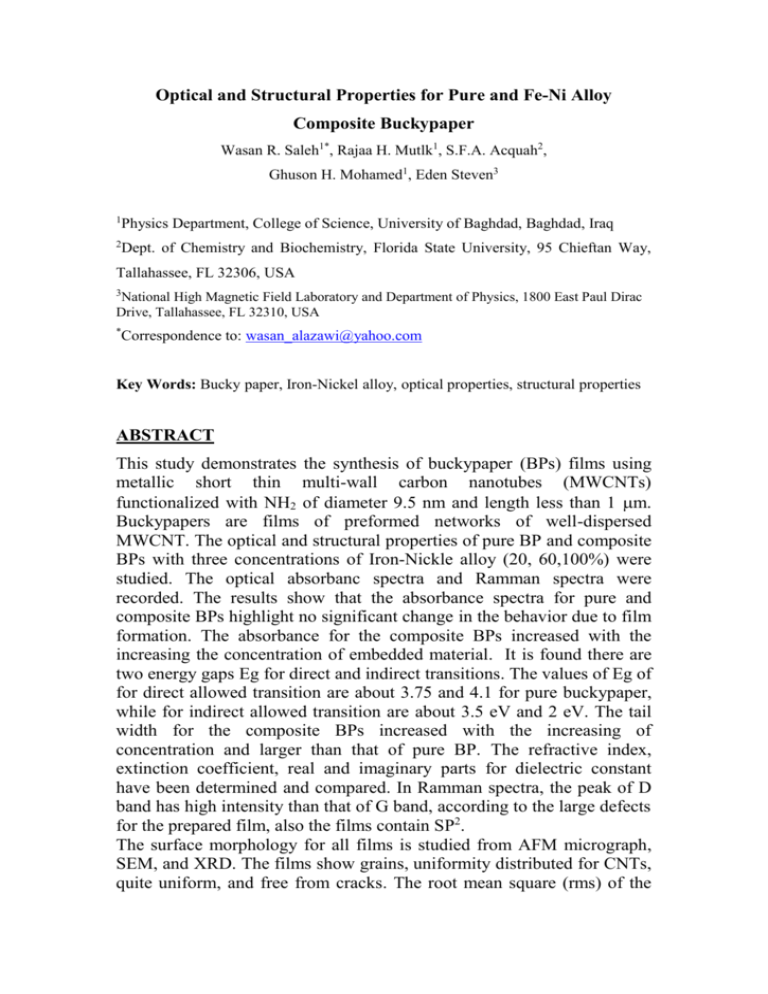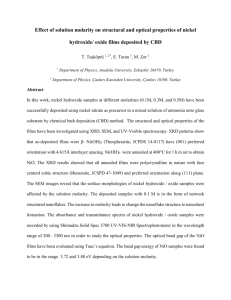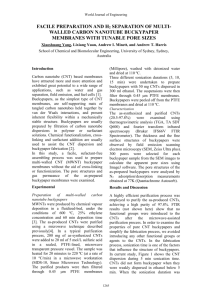abstract
advertisement

Optical and Structural Properties for Pure and Fe-Ni Alloy Composite Buckypaper Wasan R. Saleh1*, Rajaa H. Mutlk1, S.F.A. Acquah2, Ghuson H. Mohamed1, Eden Steven3 1 Physics Department, College of Science, University of Baghdad, Baghdad, Iraq 2 Dept. of Chemistry and Biochemistry, Florida State University, 95 Chieftan Way, Tallahassee, FL 32306, USA 3 National High Magnetic Field Laboratory and Department of Physics, 1800 East Paul Dirac Drive, Tallahassee, FL 32310, USA * Correspondence to: wasan_alazawi@yahoo.com Key Words: Bucky paper, Iron-Nickel alloy, optical properties, structural properties ABSTRACT This study demonstrates the synthesis of buckypaper (BPs) films using metallic short thin multi-wall carbon nanotubes (MWCNTs) functionalized with NH2 of diameter 9.5 nm and length less than 1 m. Buckypapers are films of preformed networks of well-dispersed MWCNT. The optical and structural properties of pure BP and composite BPs with three concentrations of Iron-Nickle alloy (20, 60,100%) were studied. The optical absorbanc spectra and Ramman spectra were recorded. The results show that the absorbance spectra for pure and composite BPs highlight no significant change in the behavior due to film formation. The absorbance for the composite BPs increased with the increasing the concentration of embedded material. It is found there are two energy gaps Eg for direct and indirect transitions. The values of Eg of for direct allowed transition are about 3.75 and 4.1 for pure buckypaper, while for indirect allowed transition are about 3.5 eV and 2 eV. The tail width for the composite BPs increased with the increasing of concentration and larger than that of pure BP. The refractive index, extinction coefficient, real and imaginary parts for dielectric constant have been determined and compared. In Ramman spectra, the peak of D band has high intensity than that of G band, according to the large defects for the prepared film, also the films contain SP2. The surface morphology for all films is studied from AFM micrograph, SEM, and XRD. The films show grains, uniformity distributed for CNTs, quite uniform, and free from cracks. The root mean square (rms) of the films surface roughness was indicating a smooth surface of synthesis buckypaper. XRD results how that the structure for pure BP is polycrystalline, while for composites films this crystalline decreased with the increasing the concentration of embedded material. This smart material will have wide applications in the field of sensor and detectors.







